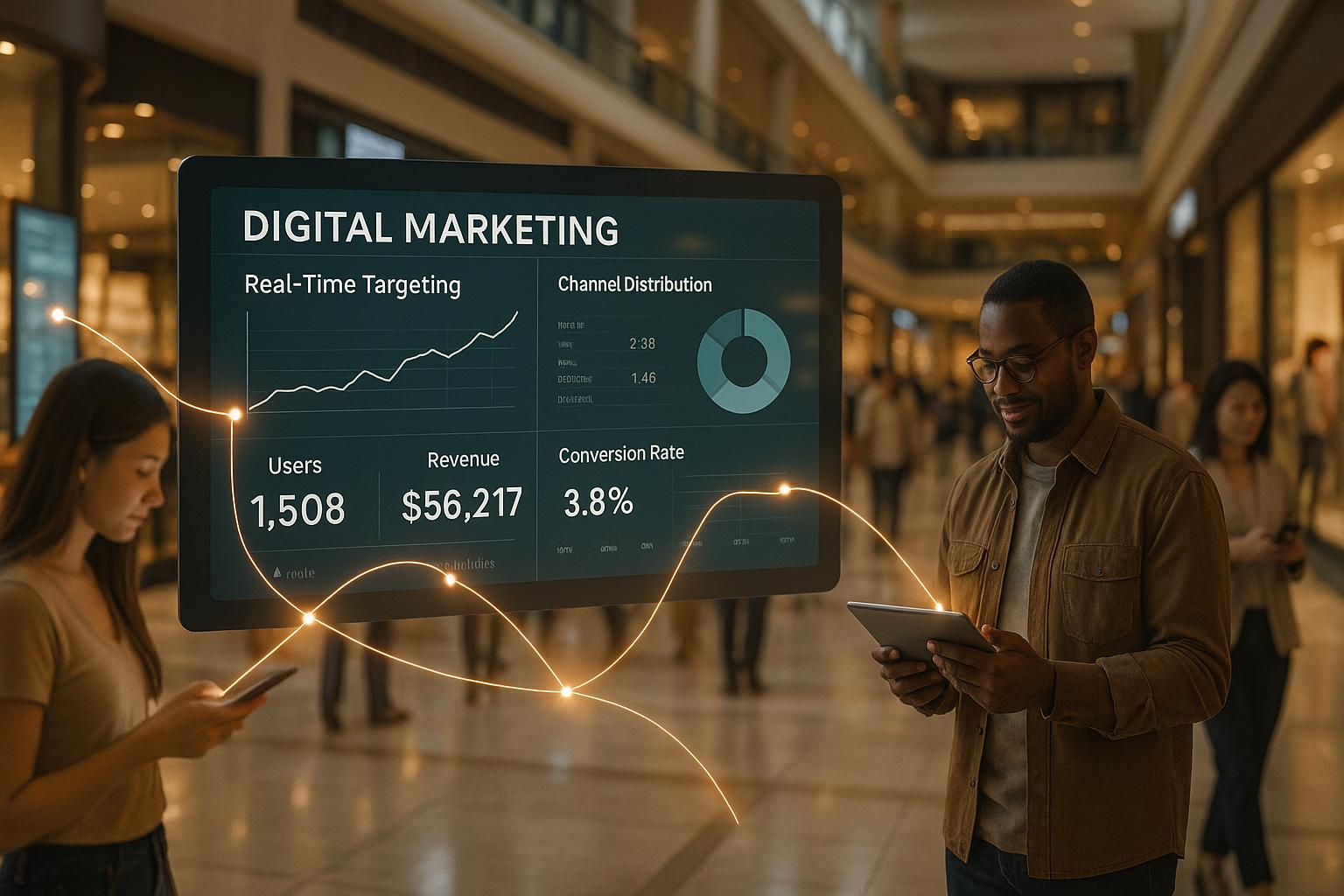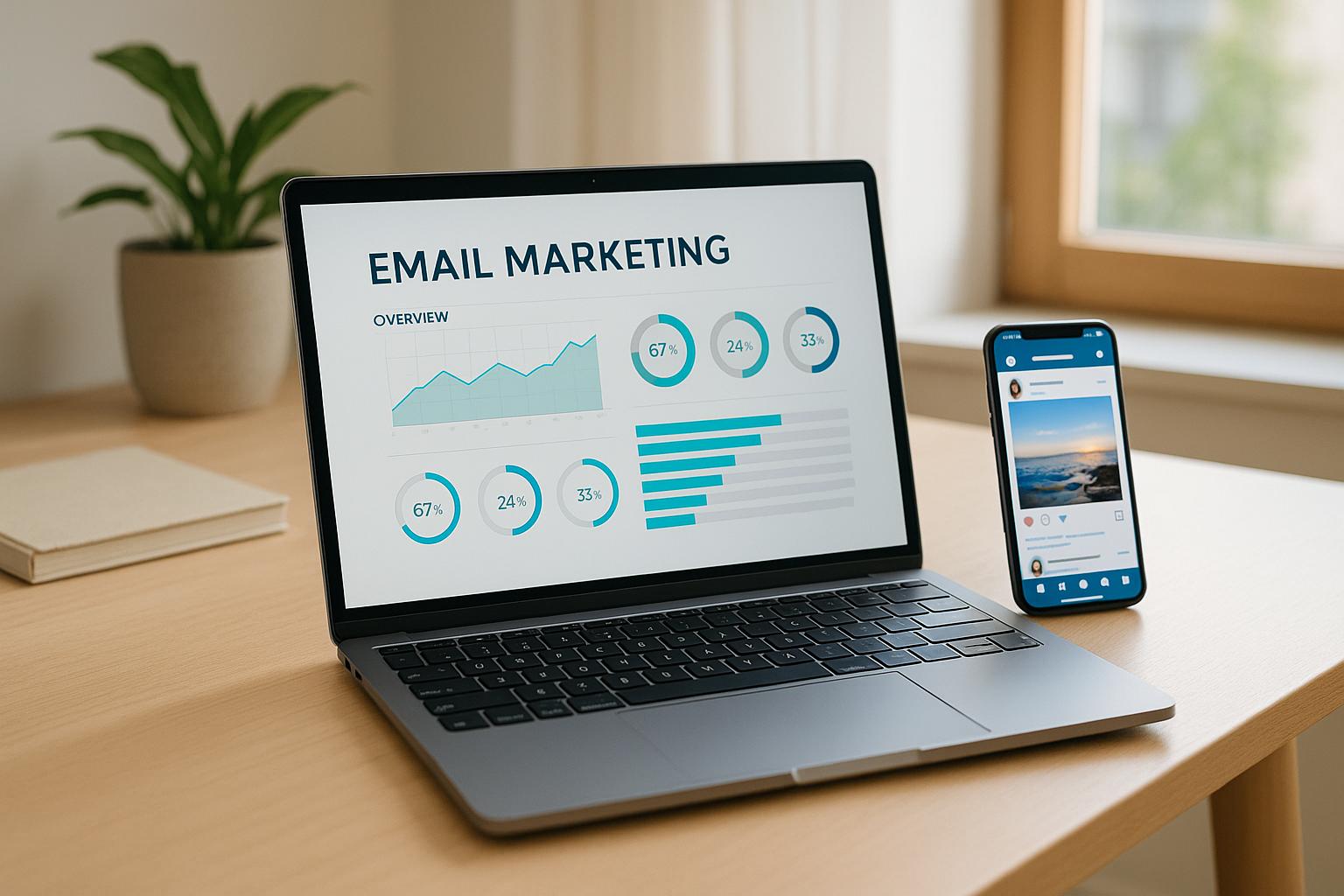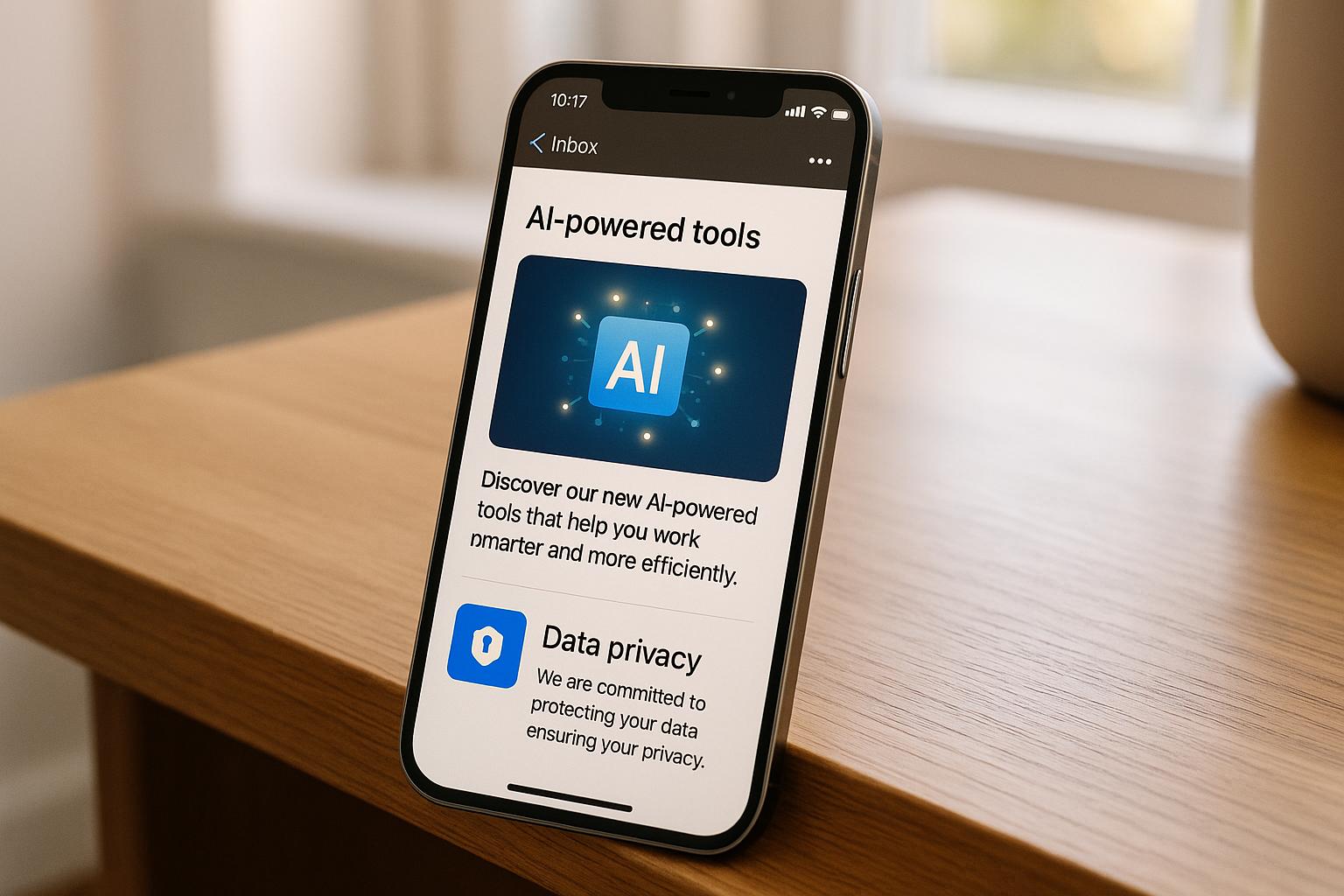AI is changing email marketing by making it smarter and more personalized. Here’s how:
- Dynamic Personalization: Emails adjust to user behavior in real-time, ensuring relevance.
- Better Timing: AI identifies the best times to send emails based on recipient activity.
- Content Optimization: AI tailors subject lines, email body, and visuals for higher engagement.
- Predictive Analytics: Anticipates user needs and improves targeting for better results.
- Automated Adjustments: Campaigns are refined continuously, boosting performance.
Want to improve your email campaigns? AI tools like Salesforce Einstein and Klaviyo help optimize content, timing, and targeting for stronger engagement and conversions.
AI & Email Marketing in 5 Minutes
Key AI Features for Real-Time Email Performance
AI has transformed email marketing by introducing tools that make campaigns more effective. These features work together to create personalized, timely emails that boost engagement.
Personalizing Content Dynamically
AI analyzes multiple data points at once to tailor emails for each recipient. It learns from user interactions to keep improving how content is delivered.
| Personalization Element | AI Capability | Impact |
|---|---|---|
| Subject Lines | Examines recipient behavior to craft subject lines that match interests and trends | Better email open rates |
| Email Body | Uses past engagement to deliver content aligned with individual preferences | Stronger engagement |
| Images | Selects visuals based on user interaction data | More appealing visuals |
| Product Recommendations | Combines browsing data and purchase history | Increases chances of conversion |
While personalized content grabs attention, sending emails at the right time is just as important.
Determining Optimal Send Times
AI identifies the best times to send emails by studying recipient behavior, such as:
- Engagement trends across devices and times
- Geographic and timezone differences
- Relevant events like holidays or breaking news
- Current levels of user activity
"AI tools like Salesforce's Einstein analyze past email performance to suggest the best time and day to send future campaigns for maximum engagement" [3]
Using Predictive Analytics for Engagement
Predictive analytics helps campaigns anticipate what subscribers need instead of just reacting to past actions. By analyzing historical data, it can:
- Forecast campaign performance
- Identify high-value audience segments
- Predict conversion likelihood
- Suggest real-time content updates
AI also adjusts campaigns on the fly by:
- Tweaking content to match new engagement data
- Modifying delivery times for better results
- Refining audience targeting
- Monitoring and optimizing overall performance
These AI-driven features create a smarter email marketing system that adapts to user behavior in real time. With predictive insights and data analysis, marketers can consistently deliver campaigns that connect with their audience and achieve meaningful results.
Steps to Implement AI in Email Marketing
Choosing the Right AI Tools
Getting started with AI in email marketing begins with selecting the best tools for your needs. Many platforms offer features that can take your email campaigns to the next level:
| AI Feature | Platform Example | What It Does |
|---|---|---|
| Dynamic Content | Klaviyo's behavioral engine | Adjusts email content based on real-time browsing habits and purchase history |
| Predictive Analytics | HubSpot's Smart Content | Predicts click-through rates and purchase likelihood using customer journey data |
| Send Time Optimization | Salesforce Einstein | Finds the best send times by analyzing engagement patterns across time zones |
| A/B Testing | Campaign Monitor | Tests and applies the best-performing email versions automatically |
Fine-Tuning Campaigns with AI
AI tools make it easy to improve campaigns by analyzing performance, tweaking content, and segmenting audiences based on behavior. For example, Campaign Monitor's AI system uses real-time data to adjust subject lines, content layout, and more, ensuring every email delivers results [1][3].
Here are some ways AI optimizes campaigns:
- Tracks performance in real time and makes adjustments automatically.
- Refines email content based on how users interact with it.
- Creates audience segments by analyzing behavioral data.
Leveraging the Email Service Business Directory
After identifying the AI features you need, the next step is finding the right tools. The Email Service Business Directory can help by comparing platforms based on factors like:
- Integration with existing systems
- Scalability for growing subscriber lists
- Advanced AI capabilities
- Tools for instant content adjustments
- Quality of customer support
This directory simplifies the selection process by offering side-by-side comparisons, making it easier to match your business needs with the right platform [2].
sbb-itb-6e7333f
Choosing Email Service Providers with AI Features
Factors to Consider for AI Email Platforms
When selecting an AI-powered email service provider, focus on features that enhance personalization and campaign performance. Automation tools like predictive analytics and dynamic content generation should simplify complex tasks while remaining easy to use. It's also essential to choose a platform that integrates smoothly with your current tools, such as CRM systems and e-commerce platforms.
Scalability is another critical factor. The platform should handle subscriber list growth effortlessly - for example, scaling from 10,000 to 100,000 subscribers without delays or errors. Flexible pricing tiers that align with your business growth are also worth considering.
Here's a quick breakdown of what to evaluate:
| Feature Category | What to Look For | Why It Matters |
|---|---|---|
| AI Capabilities | Predictive analytics, Dynamic content generation, Send time optimization | Enhances personalization and campaign success |
| Integration and Performance | API accessibility, Integration options, Data processing speed | Ensures compatibility with existing tools |
| Analytics & Reporting | Real-time metrics, A/B testing, Custom reporting | Helps refine and improve email strategies |
| Support & Training | Technical documentation, Customer support, Training resources | Ensures smooth onboarding and effective usage |
Comparing Top Providers
Several leading email platforms specialize in AI-driven personalization. Here's a comparison of some top providers:
| Provider | AI Specialization | Notable Features |
|---|---|---|
| Klaviyo | Behavioral automation | Dynamic content engine tailored for e-commerce |
| HubSpot | Predictive analytics | Smart content system with advanced lead scoring |
| Mailchimp | Content optimization | Send time optimization and content recommendations |
"AI can significantly improve email open and click-through rates by personalizing content based on individual recipient data" [1]
To find the best fit, use the Email Service Business Directory to compare platforms based on your needs. Testing is key - run pilot programs with your top choices to see how well they handle your email volume, maintain personalization quality, and ensure fast delivery.
Choosing an AI-powered email platform with advanced features can elevate your campaigns, making them more engaging and tailored in real time. The right platform can help you maximize the impact of your email marketing efforts.
Conclusion and Future Trends in AI Email Marketing
Main Benefits of AI in Email Marketing
AI has brought noticeable improvements to email marketing by leveraging advanced data analysis and automation. With dynamic personalization, emails can be tailored to each recipient, leading to higher engagement and better conversion rates.
| Benefit Category | Impact on Performance | Real-Time Capability |
|---|---|---|
| Content Optimization | More engagement through personalized subject lines and content | Instant adjustments based on user behavior |
| Send Time Analysis | Improved open rates by scheduling emails at optimal times | Continuous refinement of delivery timing |
| Predictive Analytics | Better targeting through behavior-based insights | Real-time forecasting of campaign performance |
These advancements work together to boost engagement, fine-tune timing, and increase ROI for email campaigns. While these capabilities have already reshaped the landscape, the future promises even greater possibilities.
Future Developments in AI Email Marketing
As tools like predictive analytics and real-time optimization continue to evolve, email marketing will become even more sophisticated. The next big leap is hyper-personalization, which will make email campaigns more tailored than ever.
Emerging trends include:
- Enhanced predictive analytics and real-time optimization for context-aware campaigns.
- Automated tools that refine strategies continuously based on performance data.
AI integration is also becoming more user-friendly, opening up advanced features to businesses of all sizes. Some exciting future advancements include:
| Future Development | Expected Impact |
|---|---|
| Advanced Behavioral Analysis | Better prediction of customer actions and preferences |
| Automated Content Generation | Scaled creation of personalized, AI-driven content |
| Cross-channel Integration | Smoother coordination across multiple marketing channels |
These advancements will elevate personalization and automation further, ensuring email campaigns deliver even stronger results. AI is set to make email marketing smarter, more efficient, and accessible to businesses large and small.
FAQs
What is an example of real-time personalization?
Real-time personalization uses AI to adjust email content instantly based on how users interact, making messages more engaging and relevant. For instance, in the SaaS world, AI can help businesses send tailored welcome emails right after a user signs up, trigger tutorials for features they haven’t used, or send re-engagement emails when users go inactive - all based on their individual behavior.
AI doesn’t stop there. It can tweak email timing and format based on when users are most likely to open messages or the devices they use. Beyond SaaS, retailers can suggest products based on browsing history, and travel companies can update offers dynamically based on a user’s location or recent searches.
| Action | Real-Time Response | Impact |
|---|---|---|
| Initial Sign-up | Welcome email with personalized onboarding steps | Boosts immediate engagement |
| Feature Exploration | Tutorial emails triggered by unused features | Increases feature adoption |
| User Inactivity | Re-engagement emails sent at the best possible times | Improves user retention |
To make real-time personalization work for your business, consider using AI-powered platforms. Resources like the Email Service Business Directory can guide you in choosing tools that match your needs [1][3]. These platforms help automate personalized content creation and delivery while optimizing campaigns with real-time data analysis [2].


